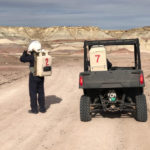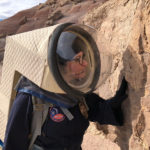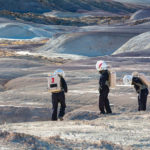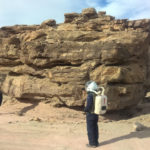[title Journalist Report – November 20th]
Wed 20 Nov Sol 10
by Guy Murphy
Water is important out here in the desert, but it is not always in the right place.
Crew maintenace of the MDRS campus includes regulating and monitoring its use, given
all water here needs to be brought in. It is rationed, and used thoughfully, in the Hab
and the Greenhab. Water can be in the wrong place when it rains, and as anticipated,
there was heavy rain last night. In the morning the pot holes, depressions and cracks
in the ground were filled with water, the clays acting as aquicludes, forming an
impermeable barrier preventing it from draining away. The crusty surface had become
slipperly mud, the landscape looking more like the liquid methane-drenched surface of
Titan than dry, dusty Mars.
Water is the focus of the in situ resource utilisation (ISRU) research we have been
undertaking during Crews 214 and 215. ISRU is a key concept for pioneering Mars. It
involves producing key products needed for human survival using resources available on
the Martian surface, rather than bringing them from Earth. These may include water,
oxygen, fuel, energy, building or industrial materials but most importantly water. It
is possible, but extremely costly to launch these things from Earth, and then it needs
to be delivered on site to exactly where it is needed. Why import your water, if you
can obtain it on site?
Andrew Wheeler’s ISRU experiments involve extracting water from the gypsum that we have
been collecting from surrounding localities whilst on EVA. This is a hydated mineral
similar to those found in surface deposits on Mars. Heating the gypsum causes the water
to be released, and today Andrew and Larissa collected over 10 millilitres from the
formerly dry, crystalline rock. This demonstrates a process which could, in principle,
be used to obtain water on Mars. This is important for human consumption, plant
production and for creating secondary products such as oxygen and hydrogen for further
processing.
Larger settlements of more than a temporary character will need Martian manufactured
building materials. To this end, its should be possible to make bricks, concrete, glass
and metals using available surface resources. Today we tested a potential Martian
technology. Andrew and Larissa used a dehydrated gypsum (called anhydrite) and sand mix
to create small cement tiles for strength testing.
[end]









You must be logged in to post a comment.